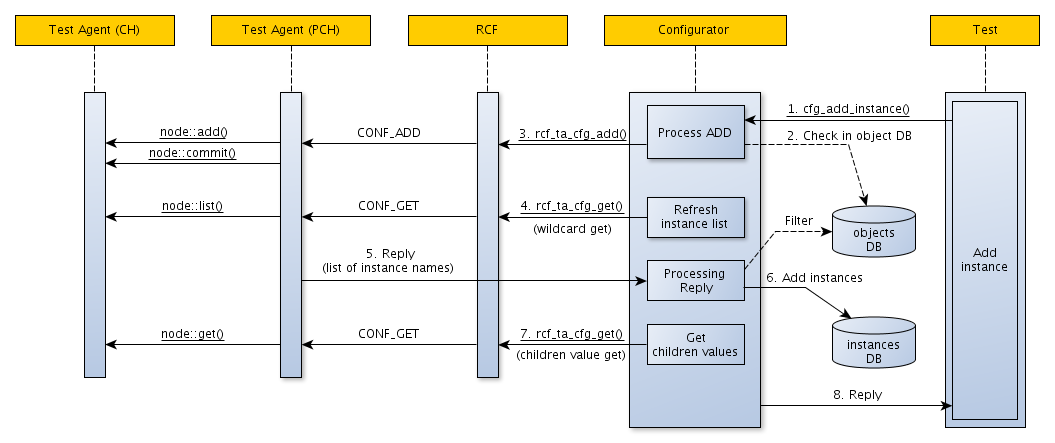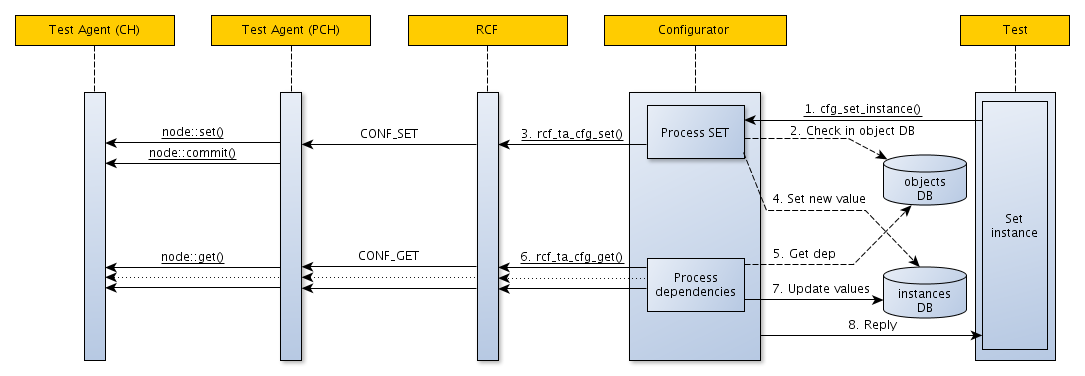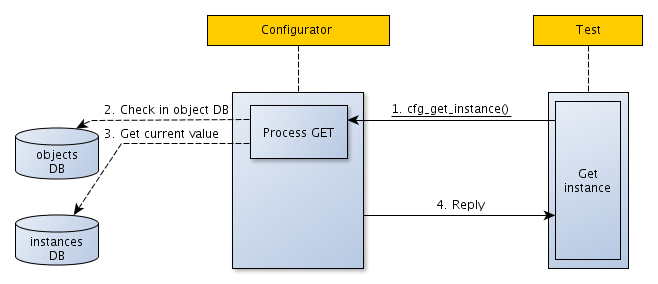API Usage: Configurator API
Usage of Configurator API from test scenarios
Test scenarios should use functions exported via:
base API: Configurator (
lib/confapi/conf_api.h);semantic based interface TAPI: Test API for configuration nodes.
Here we will show how to play with samples discussed at te_agents_conf page.
Tuning Configurator configuration file
In order to let Configurator know about instances of new nodes we should register these new object nodes in configurator tree. Then Configurator will be able to get instances of these objects from te_agents. Otherwise Configurator ignores node instances whose object nodes were not registered.

When Configurator starts it processes configurator configuration file that keeps object descriptions that need to be registered in local tree of objects (see arrow [2]).
Configuration file can also keep rules to add object instances, but these instances can not be applied for /agent subtree. /agent subtree is in control by te_agents.
Configurator should ask te_agents about these instances that is why it call rcf_ta_cfg_get() function with wildcard object instance identifier (arrow [4] in the figure).
When Configurator receives a reply with the list of object instance names it checks whether an instance name has corresponding object node in its local object tree. If yes, then it adds an instance into its instance configuration tree, otherwise it ignores an instance name and tests will not be able to access those instances until they register corresponding object nodes in Configurator (see arrow [6]).
Regarding an example described at te_agents_conf page, we should add the following lines into Configurator configuration file to let Configurator know about our new supported object instances:
<object oid="/agent/ro_object" access="read_only" type="integer"/> <object oid="/agent/rw_object" access="read_write" type="address"/> <object oid="/agent/col_object" access="read_create" type="none"/> <object oid="/agent/col_object/var" access="read_only" type="string"/>
For more information on Configurator configuration file read Configurator Configuration File section.
Adding/Deleting an entry to/from configuration tree
For nodes of “read-create” access type it is possible to add or delete an instance in run time (from a test). Access type “read-create” does not guarantee the ability to run add or delete operation, but implementation of rcf_pch_cfg_object::add and rcf_pch_cfg_object::del functions is required.
Please note that there can be “read-create” objects that do not provide implementation of rcf_pch_cfg_object::add or rcf_pch_cfg_object::del functions. This mainly means that the number of instances can vary depending on events happened on Test Agent. Test Agent reports about the number of instances of that objects with rcf_pch_cfg_object::list handler.
In order to add a new object instance you should use one of the following functions:
cfg_add_instance_fmt().
The following diagram shows the sequence of events caused by calling any of these functions.

Similar things happen when you call a function to delete an object instance:
cfg_del_instance();
cfg_del_instance_fmt().
You can also use local version of instance add functions:
cfg_add_instance_local();
cfg_add_instance_local_fmt().
The only difference is that these functions will not cause rcf_pch_cfg_object::commit function to be called after rcf_pch_cfg_object::add. Instead rcf_pch_cfg_object::commit is called when a test calls cfg_commit() or cfg_commit_fmt() function for newly created object instance.
To add a new instance of col_object object one could use the following piece of code in their tests:
rc = cfg_add_instance_fmt(&handle, CFG_VAL(NONE, NULL), "/agent:%s/col_object:%s", agent_name, instance_name); if (rc != 0) TEST_FAIL("Failed to add a new instance to 'col_object' collection");
Please note that you can also add an instance of any “read-create” object via Configurator configuration file.
<add> <instance oid="/agent:Agt_A/col_object:B"/> <instance oid="/agent:Agt_A/col_object:C"/> </add>
These lines will force Configurator to create on start-up two instances of /agent/col_object object on Test Agent Agt_A with instance names A amd C. (For more information about configuration file see Configurator Configuration File section).
Set/Get configuration value operations
More frequently used operations are to Get node instance value or to Set new value to a node instance.
To Set a node instance value use:
cfg_set_instance();
cfg_set_instance_fmt().
Or corresponding local varsions:
cfg_set_instance_local_fmt().

One useful feature of object node declaration is specifying dependencies. An object node can be supplied with the list of object nodes on whose values it depends. Then Configurator will track changes of nodes on which another node depends. In case any of these nodes changes its value, Configurator will update the local copy of values of dependent nodes.
For example we can specify:
<object oid="/agent/col_object/var1" access="read_write" type="string"/> <object oid="/agent/col_object/var2" access="read_write" type="string"> <depends oid="/agent/col_object/var1"/> </object>
This means that the value of /agent/col_object/var2 depends on /agent/col_object/var1 - any changes to /agent/col_object/var1 may cause change of /agent/col_object/var2.

To understand the necessity of dependencies we need to know how Configurator handles Get operation.
You can use the following functions to Get the value of object instance node:
cfg_get_instance();
cfg_get_instance_fmt().

Please note that cfg_get_instance() call does not cause any exchange between Configurator and te_agents, but rather value to return is got from local object instance database.
If you want to get the value from Test Agent you can do one of the following:
call cfg_get_instance_sync() or cfg_get_instance_sync_fmt() that will first synchronize object instance value with Test Agent and the return an updated value;
call cfg_synchronize() or cfg_synchronize_fmt() to synchronize a subtree of configuration nodes and then call ordinary cfg_get_instance() function.

Please note that you should use synced calls only if you are sure that object instance values can change in the backgroud, otherwise it is better to use non-synced calls in order to minimize data exchange between Configurator and te_agents.
Please note that you can also do set operation in Configurator configuration file.
<set> <instance oid="/agent:Agt_A/col_object:B/var1:" value="Some value"/> </set>
These lines will force Configurator to run Set operation on start-up for instance /agent:Agt_A/col_object:B/var1:. (For more information about configuration file see Configurator Configuration File section).